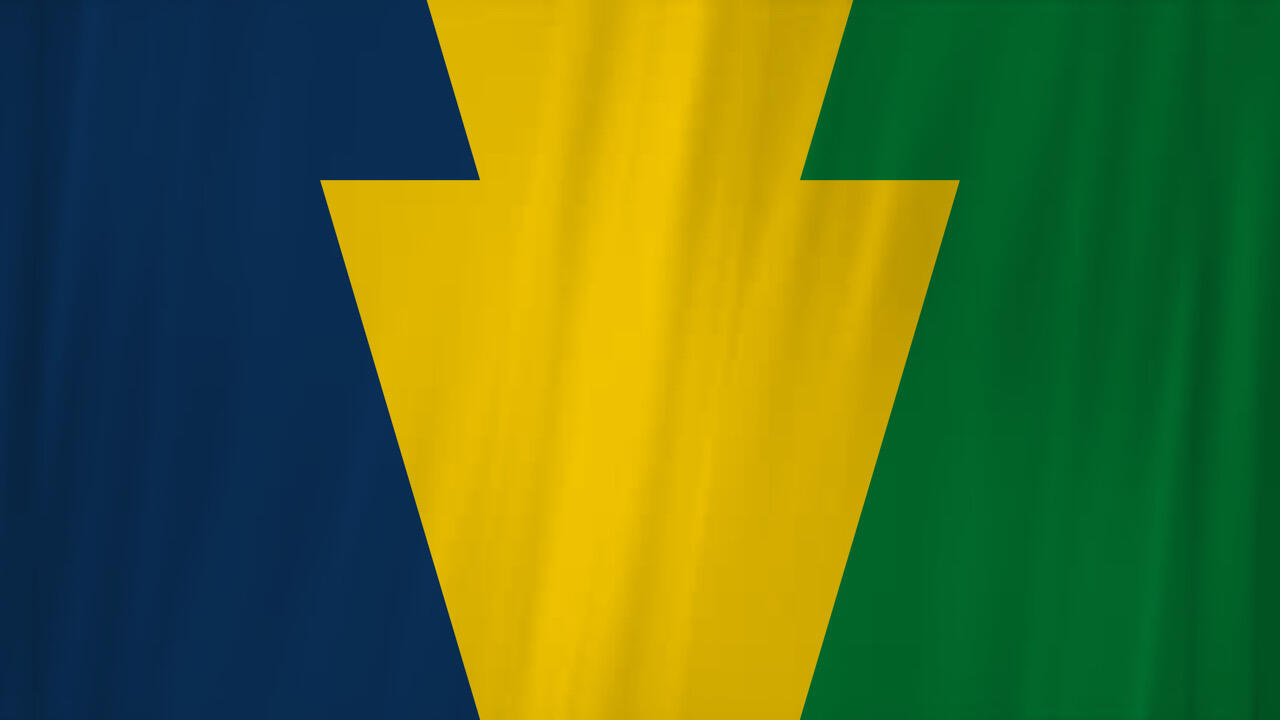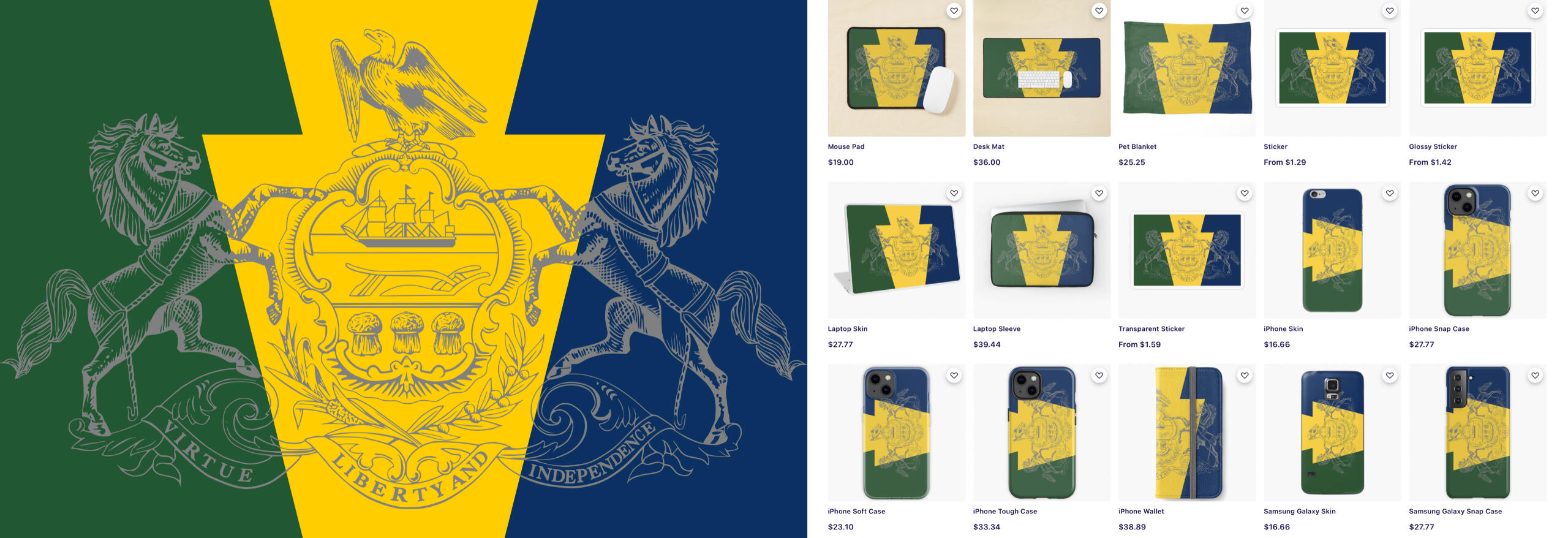A new icon for Pennsylvania
Keystone Flag
A community flag for everyday Pennsylvanians to fly with pride.
A new design
Why?
Flags are a symbol of civic pride. An iconic flag design can be remixed and incorporated into the very fabric of a community. But a poorly designed flag can instantly be forgotten and ignored, and in the worst cases, actively hidden in shame. In Pennsylvania, we have a beautiful Coat of Arms worth treasuring, but that doesn't mean it's a good flag. Below, Roman Mars gives an excellent TED talk on why flag design matters:
In a time where our divisions are more visible than they have ever been, it’s imperative that we have an iconic symbol to rally under that can remind us of our shared interest in this Commonwealth and in each other. While a Coat of Arms can be a representative of government, a flag represents a people, and a good flag can become an icon that is blended into the cultural fabric of a community.-Now, a quick experiment. Below are the flags of 50 states, five US territories, and DC. How quickly can you find Pennsylvania?
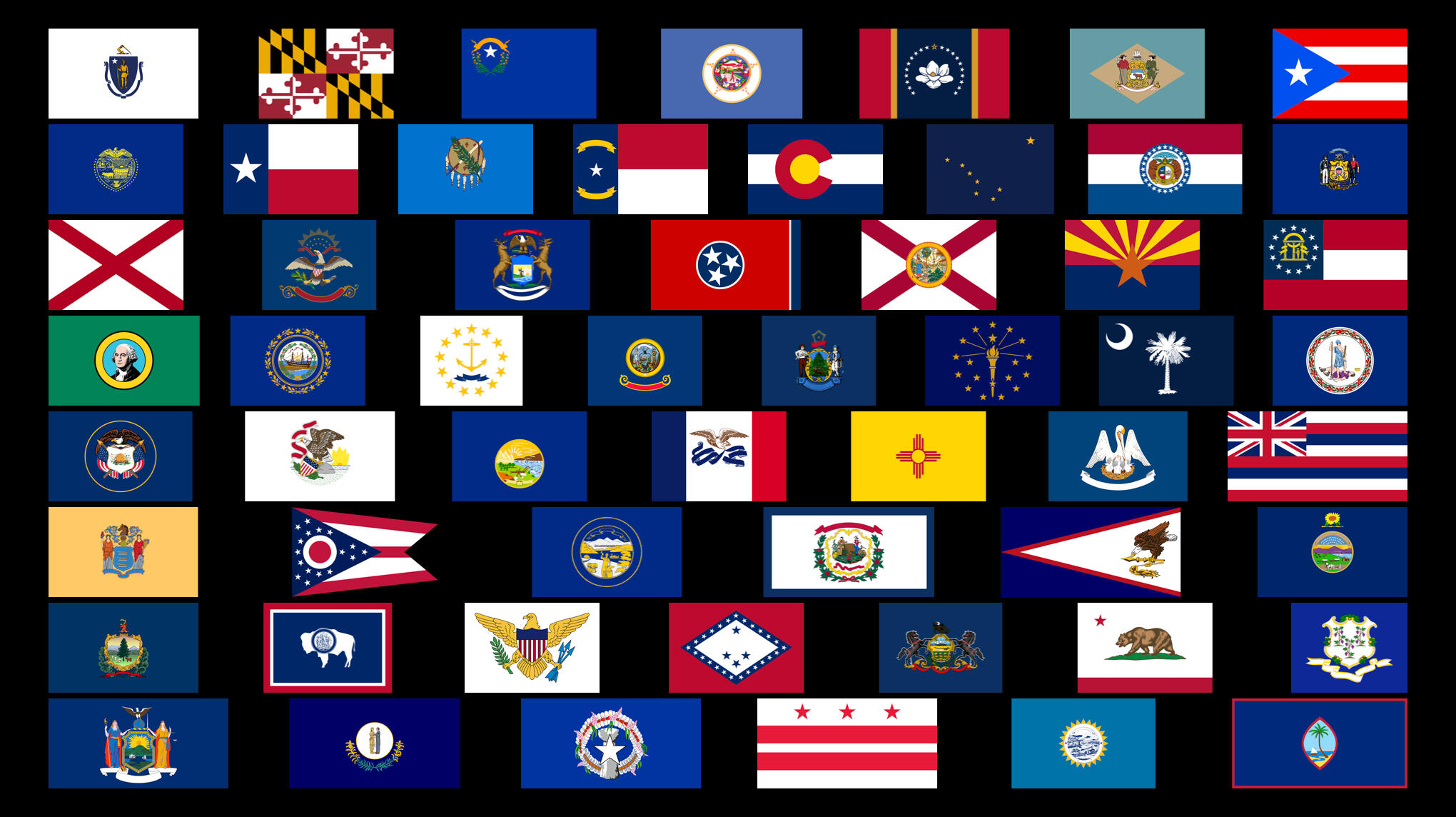
I'll try to make it easier. Let's take away all but 24...
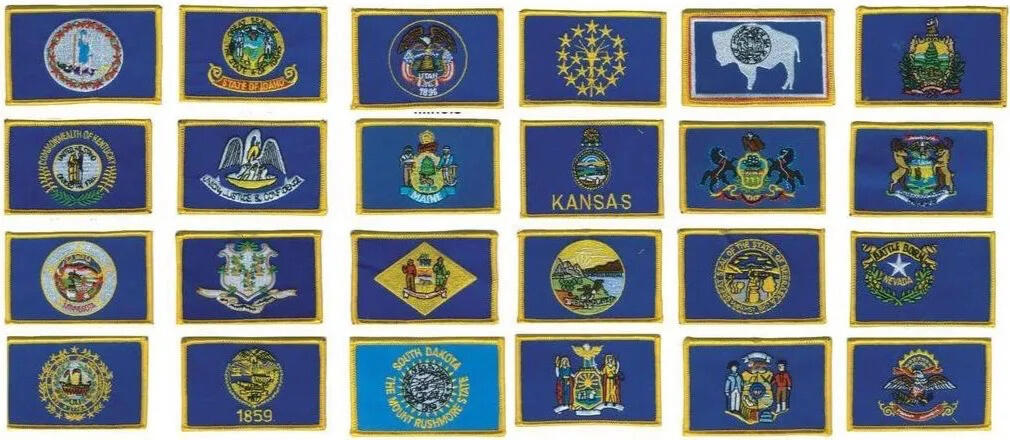
How long did that take you? The distinguishing features are so small and hard to make out, and they blend into a sea of other ineffective flag designs. Now take a look at all 56 again, and look for our neighbors Maryland and Ohio.
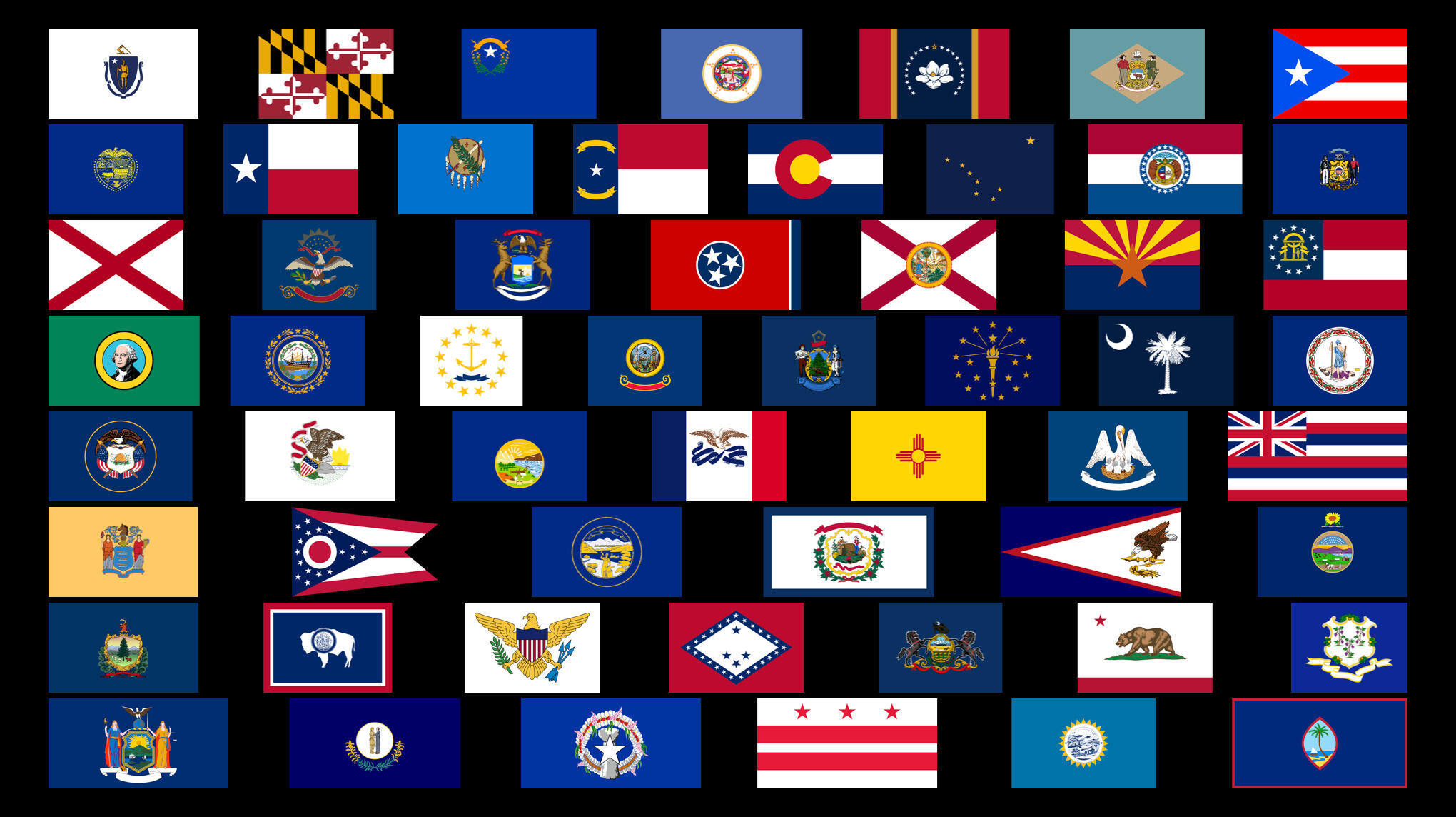
I'd bet that didn't take as long. They're distinctive! There's not much distinctive about Pennsylvania's flag.-Those who know the state flags well will know that those weren't actually the 56 flags - many of them add their name to stand out, because their symbolism wasn't effective enough to make them identifiable. Pennsylvania actually considered doing this in 2007! A state representative said at the time: "State flags are a way to celebrate our heritage and what makes us unique from other states. They serve as a rallying point and show our love of the place we call home. By adding 'Pennsylvania' to our state flag, we would ensure that everyone who sees it knows that the banner of blue and gold represents this great Commonwealth." Let's see how that proposal might have looked (and keep watching to see what happens when the wind changes direction or dies down):
Well. You might be able to tell that's Pennsylvania... when the flag's not telling you it's AINAVLYSNNEP. (Our motto flies backwards, too.)PA has a great coat of arms.
PA has a terrible flag.
We deserve better.-Here's a different 56 flag grid, composed of various redesigns (the most distinctive flags weren't changed). Find Pennsylvania, then read about the design to see how we got to a flag that still stands out distinctly as "Pennsylvania" even in a field of standouts.
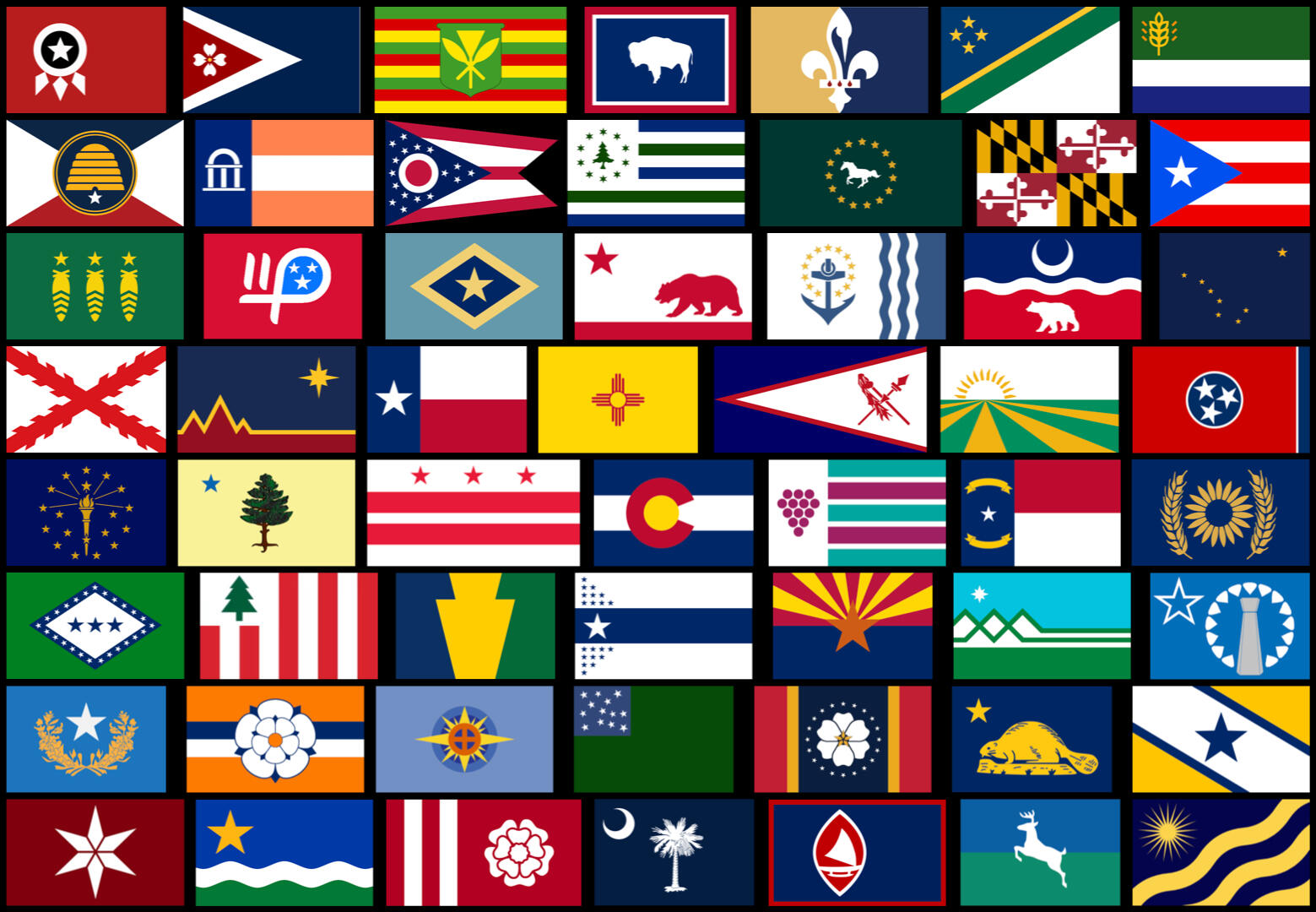
Creating an icon
The Design
One of the most difficult things about redesign is honoring what came before. Thankfully, flag scholar Ted Kaye tells us we can make this happen: "Inside every bad flag is a good flag trying to get out." Let's see what we have to work with:

Let's start with the focal point (if there was one) on the existing flag: the escutcheon (shield) in the Coat of Arms, which can also be found in the State Seal. This comes with its own symbolism baked in, which also translates when simplified to just the three main colors: green, gold, and blue.

Now that we have a tricolor palate (you'll notice we choose the blue from the field rather than the crest, which we'll talk about later in Symbolism), we can look to tried-and-true tricolor flag designs as a starting point. Here, we will choose the palles (vertical lines) over the fesses (horizontal lines), for reasons we'll explain in a moment...

Color symbolism can do wonders on its own, and keeping it simple is good for flags, but it doesn't quite feel like "Pennsylvania" yet - these colors could mean anything. So we add a uniquely Pennsylvania twist - turning the middle pale into a keystone, the only existing recognizably Pennsylvanian icon.

After experimenting with several different proportions, we settle on one that is balanced and easily replicable any way you stretch it, to ensure the keystone is still recognizable in a stiff breeze and the tricolor is identifiable. If we put the hoist (the part of the flag affixed to the pole) on the blue, when there is no wind, this design actually resembles the shield in the flag we started with - we've preserved some tradition!
For the exact colors, dimensions, construction sheet, and other specifications of this design, feel free to reference the Keystone Flag's Wikimedia page.(If you want to try your own flag design in the wind, we used this flag waving tool to experiment.)
While some decisions may seem more obvious than others, they were all made with the intention of preserving the symbolism on the current flag. We go into detail in the next section on symbolism.
Why things are what they are
Symbolism
While Pennsylvania's current flag design is not particularly good for a flag, there is a lot of symbolism in the coat of arms that deserves to be carried forward.This flag's design closely resembles a tricolor, because aside from the distinctive Keystone shape at the center (to represent Pennsylvania's identity as "the Keystone State"), those three colors alone can carry all of the symbolism from the traditional flag, and then some more.Wherever possible, we display the Keystone Flag with green on the left and blue on the right (there is no "backwards" with flags that fly in the wind!) to make the symbolism easier to explain:

Remember that our design is derived from Pennsylvania's state seal and coat of arms, featured in the current flag. The meanings in this state seal carry over, maintaining the tradition of the flag: green for "wealth of human thought and action," gold for "rich natural resources," and blue for "state commerce being carried worldwide."

These colors may also be used to carry over the tradition of the state motto, "Virtue, Liberty, and Independence." While these words are in written form on the current flag, near impossible to see at a distance or when flying, the three colors wind up being sufficient - green for Virtue (aligns closely with human thought and action), gold for Liberty, and blue for Independence.
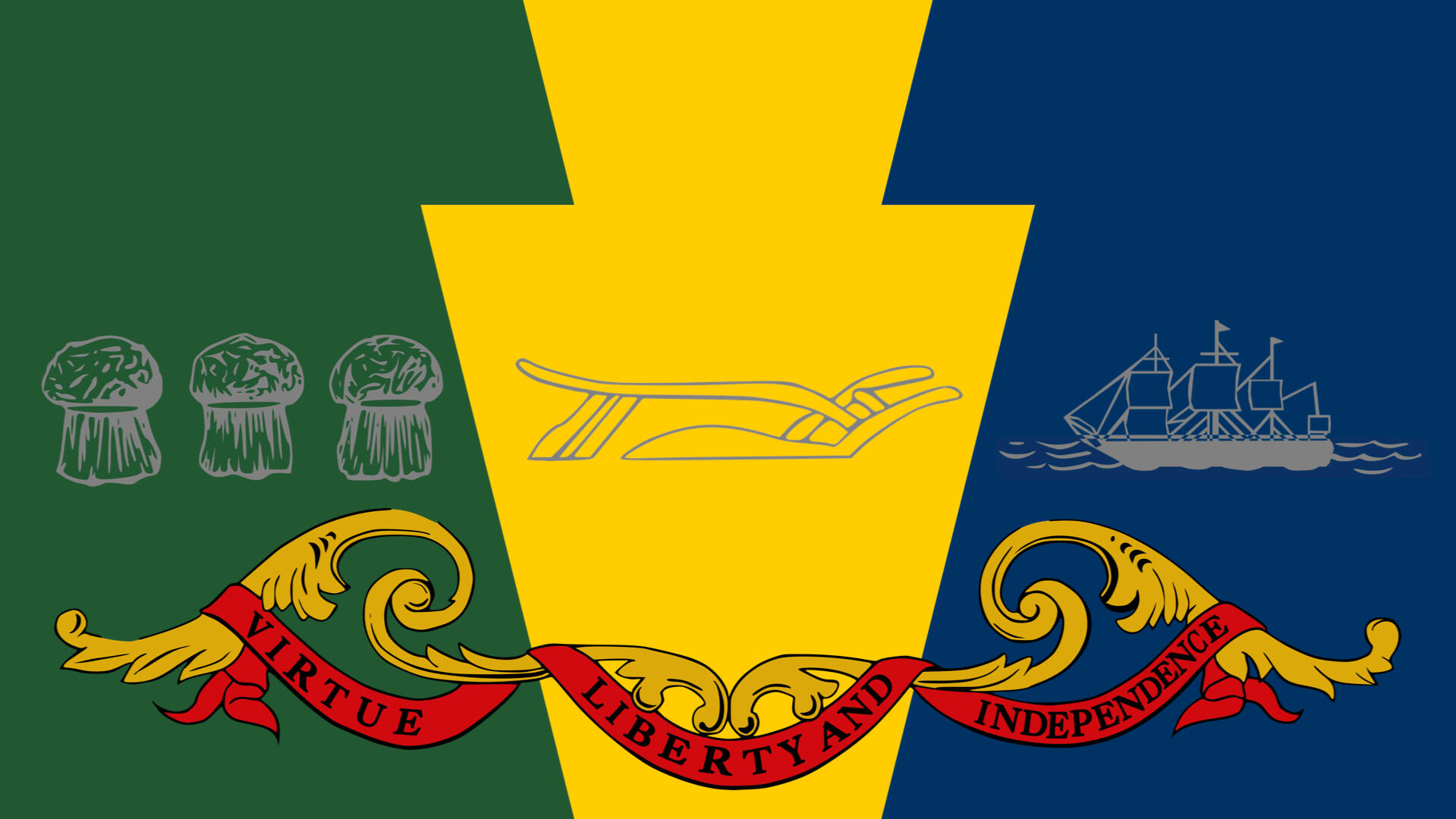
This last point allows us to tie our identity as a Commonwealth back to our identity as a US State: the Declaration of Independence was signed here in Pennsylvania. That is why the blue is darker, and why the hoist is on the sinister/blue side: to match the blue on the US flag, as does the background of our current flag. This also fulfills the symbolism of the Eagle on top of the escutcheon in the Coat of Arms on the original flag.
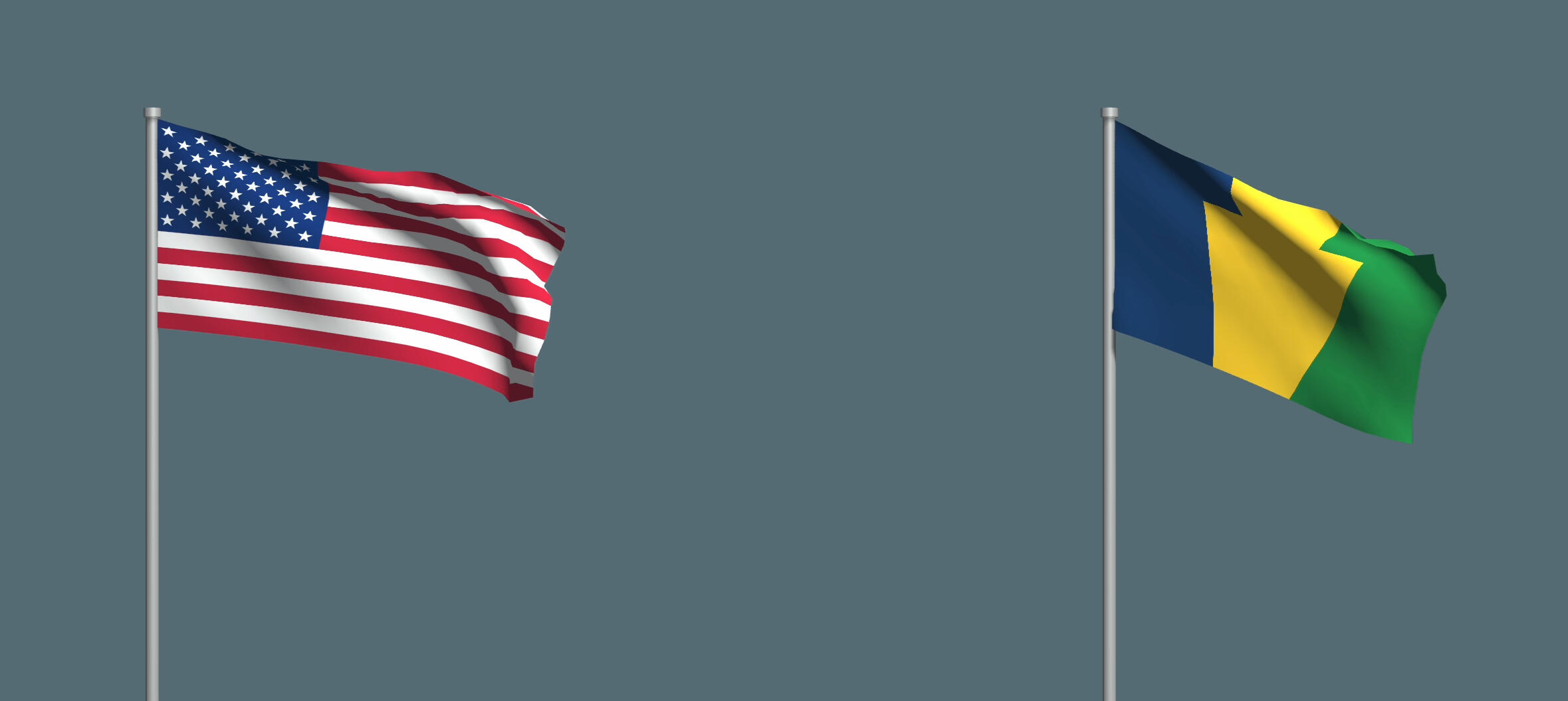
And a fun bonus: green, gold, and blue just so happens to create a (very) rough map of our west-to-east geography: green for our western hills and mountains, gold for rich farmland in much of the midstate, and blue for our eastern border along the Delaware river, home to many points that facilitate state commerce.
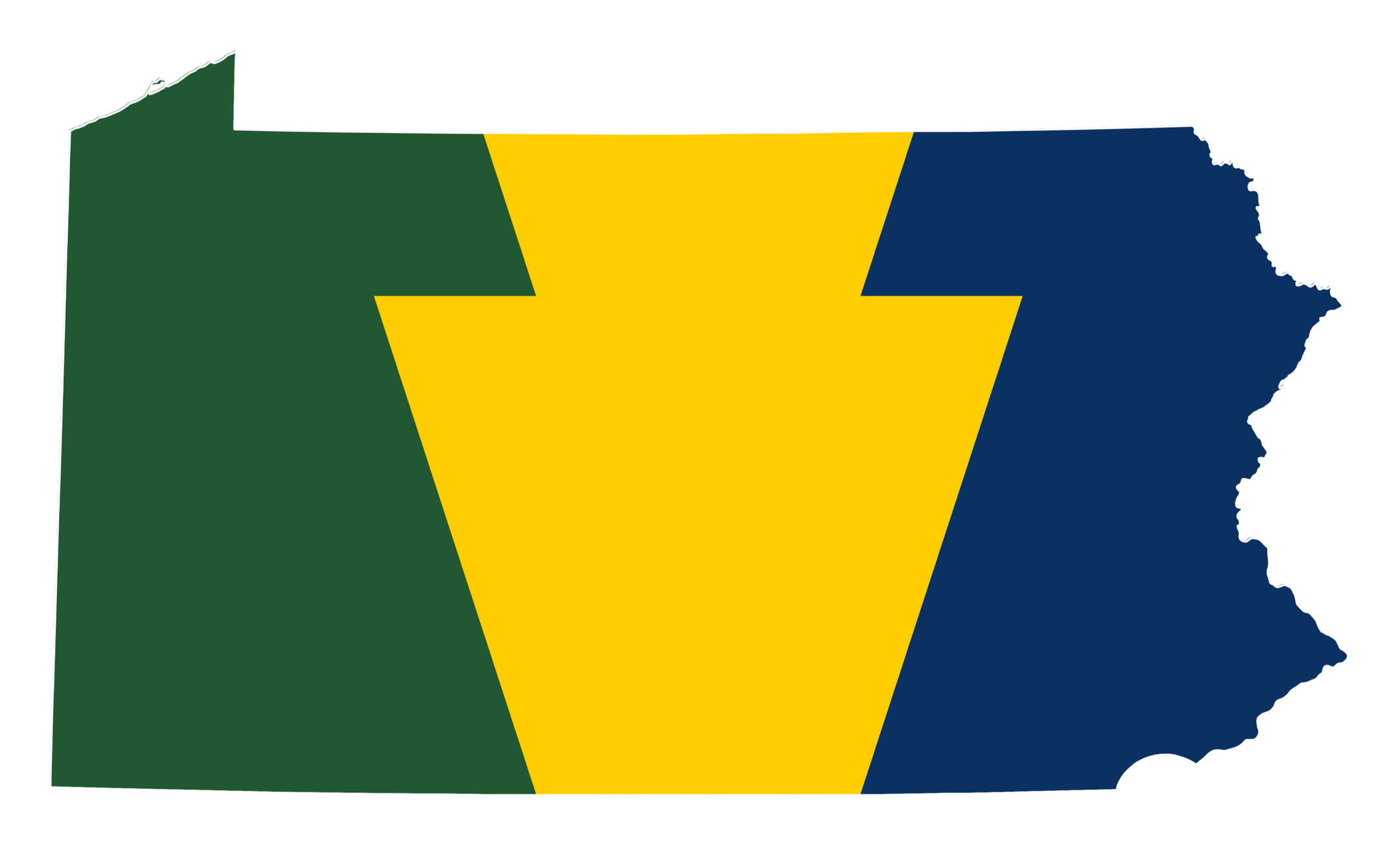
Now, take a look at the flag below. Notice how, when the wind dies down, it looks a whole lot like the crest in the original coat of arms. It goes further: the colors create visual symbolism of a rich and fertile land under a blue sky.

All of the symbolism in the original flag (and then some), but instead of intricate details and writing that is impossible to see or appreciate when flying, it's carried by three simple colors you can actually see in the wind (or no wind at all).
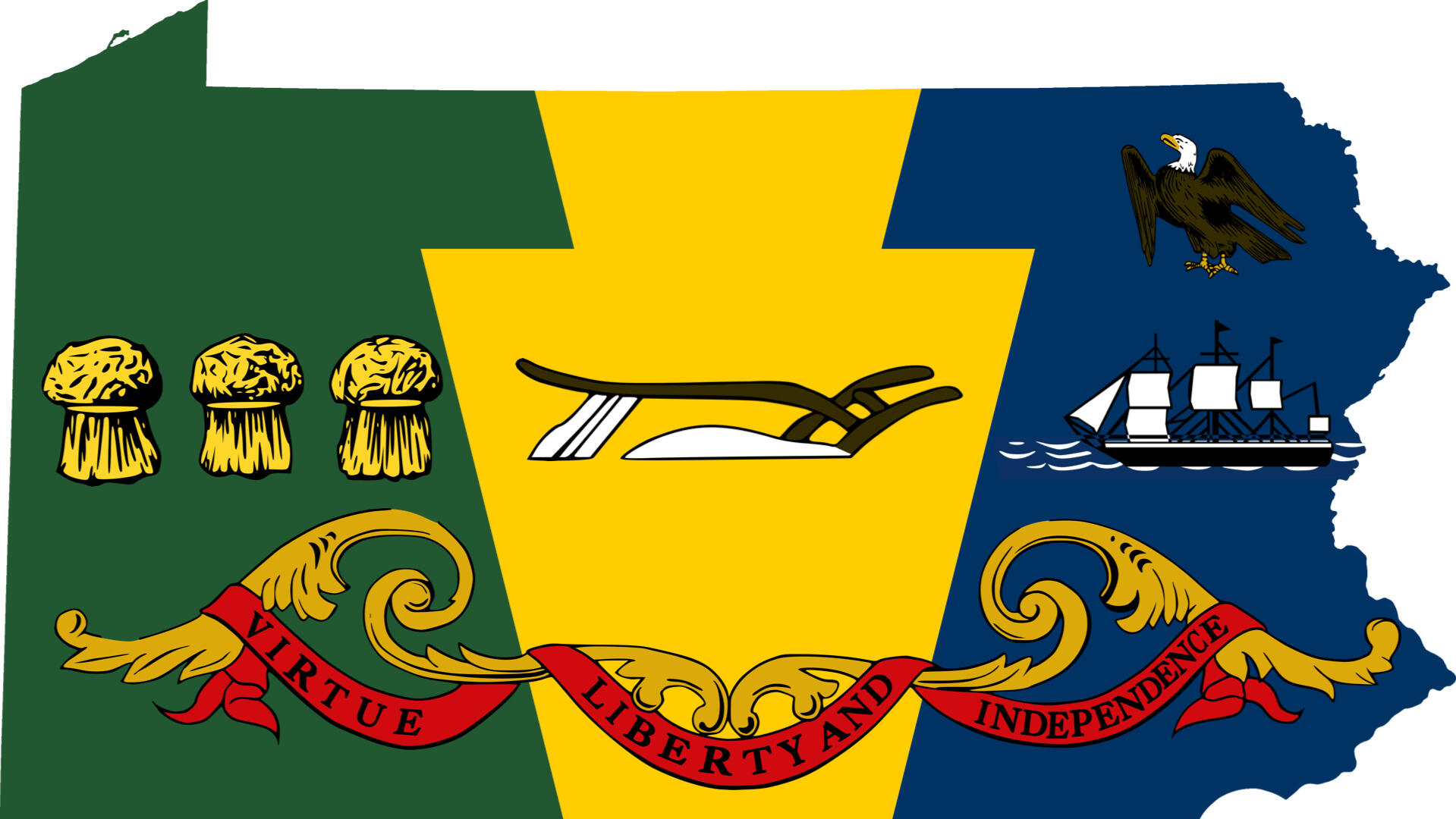
(Many of these meanings were sourced from Pennsylvania's official government page listing state symbolism.)
Specifications
Making your own Keystone Flag, or products based on the design? Here's what you need to know:- The design is dedicated by designer Tara Stark to the public domain! Here's what that means.
- Below is an image depicting the construction of the Keystone Flag. If you construct the flag at a different ratio, keep in mind that the keystone will get wider along with the flag - that's by design!
Now for some technical speak:- The Keystone Flag is composed of a bicolor divided midway along the breadth, green at the fly, and blue at the hoist; charged with a gold Keystone spanning the entire breadth of the flag.
- The Keystone shall be composed of two vertically stacked isosceles trapezoids, the smaller above with a height of 1/4 the flag’s breadth, with an upper base of 1/3 and lower base of 1/4 the flag’s length, the larger below with a height of 3/4 the flag’s breadth and upper base of 1/2 and lower base of 1/4 the flag’s length.
- The proportions of the flag must ensure the Keystone is still identifiably a keystone and constitutes approximately one third of the flag, thus, the total length of the flag may be no less than one and one half the breadth, and no more than twice the breadth.
- The three colors of the Keystone Flag are blue, gold, and green. The shade of blue matches the blue on the Flag of the United States, the shade of gold is "bright and vibrant," the shade of green should "both complement the blue and contrast the gold." The Pantone, RGB, Hex, and CMYK color specifications as defined by Keystone Flag designer Tara Stark can be found via the Keystone Flag's page on Wikimedia Commons.
Get Involved!
Under the banner of the Keystone Flag, we're building a community of Pennsylvanians who are passionate about generating civic pride through good flag design. If you want to share yours, and keep up with any Pennsylvania flag news, check out our Facebook group, the Keystone Flag Flyers.Though there may not be a realistic path to adoption of a new state flag in Harrisburg right now, there is a place you can make a change: local flags! There are 2,560 municipalities across our 67 counties, and if you've never seen your municipal/county flag (if one exists!), it's probably a good candidate for change. If you're interested in designing a new flag, or getting one officially adopted, email info@keystoneflag.org and tell us why your municipality/county is ready for change! (Bonus points if you already have some designs in mind!)
Here's a few flag desigining resources:
• NAVA - the North American Vexillological Association's page on flag design guidance
• Logo Lab to test for legibility in different situations
• FlagWaver - for testing designs in varying wind conditions
Testimonials
I found something new to obsess about. Well done, @KeystoneFlag (and designer Tara Stark!) for a simple, elegant rethink of the commonwealth's flag.
— Greg "Raise the cosmic diffuser!" Lester (@Greg_Lester) October 7, 2022
I'd sign a petition today. https://t.co/oHtRDaz0rT
After the Steelers-Eagles game, I’m realizing that both Pittsburgh and Philly have tricolor flags that would pair nicely with the #keystoneflag over our current flag. Time for a change. @KeystoneFlag pic.twitter.com/y61iEVBUN1
— theodore 🌹⚓️ (@theodoresomes) October 31, 2022
Dang, this should totally be the flag tho, like you can look at it and actually know what state its for. I hope it gets more momentum and use!
— funcle syd 🏳️⚧️ (@SydSandberg) September 16, 2022
One of the best compliments I’ve gotten on the design: pic.twitter.com/hTUPfdLpnQ
— Keystone Flag (@KeystoneFlag) August 3, 2022
"...the best redesign for Pennsylvania I've ever seen." - Ted Kaye, Secretary of NAVA"I found something new to obsess about. Well done, @KeystoneFlag (and designer Tara Stark!) for a simple, elegant rethink of the commonwealth's flag. I'd sign a petition today." - Greg Lester, Jenkintown"After the Steelers-Eagles game, I’m realizing that both Pittsburgh and Philly have tricolor flags that would pair nicely with the #keystoneflag over our current flag. Time for a change." - Theodore Somes, Pittsburgh"This should totally be the flag...you can look at it and actually know what state its for. I hope it gets more momentum and use!" - Syd Sandberg, Philadelphia(Believe it or not, this next one is actually a compliment:) "...you flag design looks like something I could make in MS paint." - Bob Smith
FAQs
Nope. Official entities of the Commonwealth that fly flags will continue to fly the existing flag. This one is a community flag for the rest of us everyday Pennsylvanians to show our pride.
Not necessarily. As cool as it would be to see happen someday, previous attempts to officially adopt redesigns have either fallen flat, or worse, been actively pushed back against, tarnishing the reputation of those designs and making their future adoption more difficult. For now, it's best to not risk forcing a new design on Pennsylvanians who don't want it or will actively fight it (often in the name of tradition, a perfectly fine thing to value).
That said, the Keystone Flag is a great ice breaker to talk to neighbors about how good flag design can help communities rally together (and remember, your elected representatives are technically your neighbors, too!). Rather than creating conflict, we can create a grassroots movement of Pennsylvanians who love this design voluntarily displaying their pride, sharing it with others, and finding creative ways to incorporate the Keystone flag everywhere they can until it is so ubiquitous people begin to ask, "wait - it's _not_ official?"
In the sense that it’s progress in flag design, sure, but that’s it. The Keystone Flag is not about making any particular political statement. It's about creating a sense of civic pride for all Pennsylvanians. Every time the Keystone Flag flies, it should be a reminder that we're all in this together. So if it gives you that sense of civic pride, or inspires you to work to make Pennsylvania a better place, then it’s done its job.
We get a LOT of suggestions about where people think the Keystone Flag design fails, so we've compiled a separate FAQs about design elements on the flag! If your question isn't answered there, please feel free to email us or tag us with a question on our Twitter.
1) You can take a look at all the flags and other merch we've found online on our merch page. If you know of any merch that's not listed on our site, let us know and we'll get it added!
2) You can make your own! The design is in the public domain, and so anyone is welcome to make merch of any kind with no permission or licensing fee required, and can even sell it if they want. If you decide to sell your own merch, tell us and we'll be happy to get it added!
If you made/obtained some Keystone Flag merch, share it with our Facebook group! We love to see some Keystone pride.
Other questions? Email info@keystoneflag.org.
FAQs
Specifically, regarding
the design:
When a flag design takes off, a lot of changes get suggested by the wider public! After careful consideration, some of those changes have been implemented over the last six years, and some of them were ultimately best left alone. Here are some of the most common suggestions we've gotten that didn't quite make the cut, and why the Keystone Flag is a stronger icon for all Pennsylvanians as a result.
Those three colors come from the Pennsylvania coat of arms, which is also featured on the current state flag. Those three colors can carry the symbolism of the coat of arms forward in a design you can actually see, even when the flag is draped on a pole with no wind.
They come from the colors in our coat of arms, featured on the current flag - this carries both the symbolism and history forward in a way that inspires people (like yourself!) to ask about it! There’s more on the design and symbolism at https://t.co/LYosi5Mdr7 pic.twitter.com/0lAKNUB94Z
— Keystone Flag (@KeystoneFlag) February 21, 2023
The Keystone Flag uses blue, gold, and green together in that order to carry the symbolism and honor the history of the coat of arms on our current flag, and without green, almost all of that symbolism is lost.
Contrary to popular belief, Pennsylvania doesn't actually have any official state colors - people just assume we do because they've been on our license plates for so long, or because our current flag is primarily blue and gold (if our current flag is considered "blue and gold," then so are the flags of 23 other states). Finally, if the flag was only blue and gold, it might resemble Philadelphia's flag too closely - this ought to be a flag for all Pennsylvania, without highlighting any one particular region above others.
One could argue that our pride in these industries is actually pride in labor, natural resources, and human ingenuity. These values are already communicated by our current coat of arms, from which the Keystone Flag colors are drawn. Coal was not a part of Pennsylvania’s founding, and regardless of how one may view its legacy, even now it has already been almost entirely superceded by natural gas. Steel isn’t the industry here that it once was, either, and is often associated with both Pittsburgh (this ought to be a flag for all Pennsylvania, without highlighting any one particular region above others, and Pittsburgh already has their own stunning black flag) and Andrew Carnegie (who left behind a complicated legacy).
When designing a flag, one must keep in mind every small detail sends a message. Do we want to communicate that we are attached to a particular time in Pennsylvania’s history that has already gone (and which may not be looked at fondly in the future)? Or do we want to communicate our pride in gifts and values that came before and will outlast any particular resource or industry?
Flags communicate what we are most proud of. Are we proud of being the second state? If so, why?
Pennsylvanians are certainly proud of our place in American history, but our order of admittance has nothing to do with that - Delaware does not have more claim to American history simply for being first! Instead of using #2 symbolism, the Keystone Flag is connected to the US flag in its use of Old Glory Blue (the same blue as the US flag) in the canton and hoist (same side as the US flag), the same way the eagle cresting our coat of arms symbolizes our connection to the US.
The Liberty Bell is a very Philly symbol. While some say "it represents Pennsylvania's role in our nation's founding," that's leaving out a lot. The bell represents important moments that happened in Philadelphia, but the state/national capital has also been in Lancaster, the Articles of Confederation were signed in York, and beyond our founding, the Whiskey Rebellion took place in Western Pennsylvania, battles were fought on Lake Erie, the most widely-discussed Civil War battle took place in Gettysburg, the industrial revolution was nearly as much impacted by Bethlehem as Pittsburgh...
Businesses don't use the Bell in their logo outside Philadelphia's collar counties. People don't get Bell tattoos to represent growing up in Altoona. We need a design for all of Pennsylvania, not just Philly, and the Keystone is already ubiquitous across the commonwealth.
Many Pennsylvania flag redesigns do feature the three dishes of William Penn. However, one must be careful when enshrining the legacy of an individual, as they will inevitably be judged by different standards as culture changes. The rise and fall of Confederate monuments and the slaveholding legacy of many founders (including Penn) are just a few examples of this phenomenon. While it may be difficult to imagine, it’s possible a future culture may want to change the name of our commonwealth if Penn were ever to fall out of favor. If we are to adopt a new flag, it ought to outlast the legacy of any one individual, and instead represent values that we will always care about.
All PA keystones look wonky! In the architectural sense, a keystone technically doesn’t have to be anything other than “the one that holds the rest together,” and outside of Pennsylvania, is often just an extravagant trapezoid, if it’s decorated at all.
The “top hat” is more prevalent in Pennsylvania, but there’s no real guideline on what that “top hat” should be. There’s actually a lot of variation within state branding, let alone the keystone in branding many Pennsylvania groups have adopted. There are many ways to shape a smaller trapezoid on top of a larger trapezoid.
The keystone on the Keystone Flag was designed for a different purpose than most keystone branding - it has to be easily identifiable on a waving flag in the distance in varying and uneven wind conditions, and easily replicable.
It actually had several different variations in height and width before landing on its current form. Often, smaller “top hats” lead to it being misinterpreted as just a regular old stripe, instead of a keystone.
The larger “top hat” exaggerates the identifying “keystone” features, and makes them easier to spot at a distance and in low/uneven wind conditions. The dimensions are also easy to replicate without precise measuring tools (with the exception of the ⅓ length top edge, every vertex lands on some multiple of ½ˣ).
Many Pennsylvania redesigns have used smaller keystones! The thing about flags is they need to be identifiable at a distance and in low wind. No matter the size or placement, the detail that makes the Keystone identifiable will eventually fail at a great enough distance or in low enough wind - the question is how you want the flag to be seen when that failure inevitably happens.
"Why is the keystone so tall on the #KeystoneFlag?" Why isn't it a regular keystone?"
— Keystone Flag (@KeystoneFlag) February 18, 2023
Inevitably, every flag design will fly in poor conditions, details will be lost, and symbolism hinging on that detail may fail. Here's a "regular" keystone next to the #KeystoneFlag: pic.twitter.com/LYvteFLrLA
The Keystone Flag design can be thought of as a “tricolor with a Keystone twist” - when you are far enough away and can no longer see the detail of the Keystone, it simply looks like a traditional tricolor flag - not only that, but a tricolor that pays homage to our historical coat of arms. On the other hand, putting a smaller Keystone in the middle would get lost as a bicolor with a dot or square in the center - or worse, if the wind is low and the flag is folded over itself, the keystone may be hidden altogether!
If your question isn't answered here, please feel free to email us or tag us with a question on our Twitter.
Merch
FLAGS! Here's where we've found flags online:
Flags For Good
- (3'x5', 200D poly, printed 90% bleed)
- (Pride variant also available)KiwiVexArt (via Etsy)
- (34.5"x56", poly, printed 0% bleed (white back))Other swag:
Click here for a collection of all the Keystone Flag designs we've found available on hundreds of products via Redbubble
Others
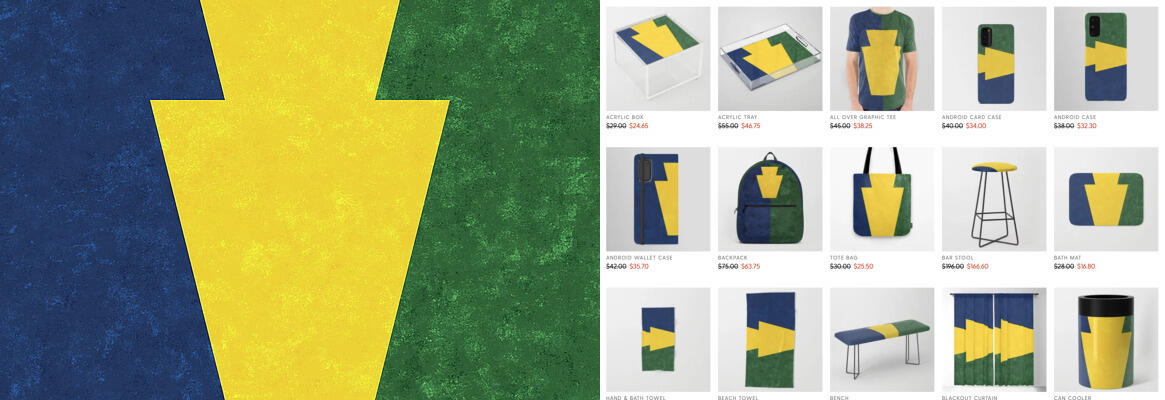
Enzwell (via FineArtAmerica) (via Redbubble) (via society6)
(If you know a retailer selling Keystone Flag merch not listed here, please email us (info@keystoneflag.org) with a link so we can add them and promote their work!)
About
The Keystone Flag was designed by born-and-raised Pennsylvanian Tara Stark in 2017 as a redesign for Pennsylvania's state flag after seeing a 2015 TED Talk on flag design by Roman Mars. While the Keystone Flag is far from the first PA redesign published online to feature a keystone, it is one of very few to make the keystone an integral element of the design akin to a stripe in a tricolor flag, and not just a charge on top of another element. It is also the first to incorporate the colors from the existing coat of arms into that style (previous "keystone tricolors" drew inspiration from the PA license plate).The exact color shades and shape of the keystone saw dozens of adjustments over several years before and during an enthusiast's redesign contest on Facebook in 2019, where it handily beat over 500 competing designs thanks to the support and votes of hundreds of Pennsylvanians who, prior to the contest, may not have realized how much they cared about flag design. The design and specifications have since been released by Stark into the public domain.In December 2022, over $4500 was raised via Kickstarter to create the first large run of flags, pins, patches, and more. As the design is public domain, some other merch is currently sold by various designers/outlets, and featured on our merch page. (If you're selling Keystone Flag merch online or in-person and aren't already on our page, please contact us so we can add you to our list and send some traffic your way!)
